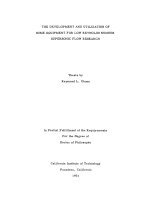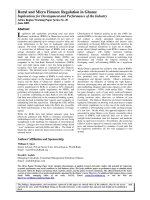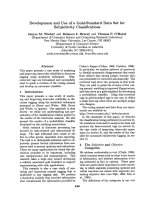Development and regeneration of muscle tissue
Bạn đang xem bản rút gọn của tài liệu. Xem và tải ngay bản đầy đủ của tài liệu tại đây (63.51 KB, 4 trang )
Development and Regeneration of Muscle Tissue
Development and
Regeneration of Muscle
Tissue
Bởi:
OpenStaxCollege
Most muscle tissue of the body arises from embryonic mesoderm. Paraxial mesodermal
cells adjacent to the neural tube form blocks of cells called somites. Skeletal muscles,
excluding those of the head and limbs, develop from mesodermal somites, whereas
skeletal muscle in the head and limbs develop from general mesoderm. Somites give
rise to myoblasts. A myoblast is a muscle-forming stem cell that migrates to different
regions in the body and then fuse(s) to form a syncytium, or myotube. As a myotube
is formed from many different myoblast cells, it contains many nuclei, but has a
continuous cytoplasm. This is why skeletal muscle cells are multinucleate, as the
nucleus of each contributing myoblast remains intact in the mature skeletal muscle cell.
However, cardiac and smooth muscle cells are not multinucleate because the myoblasts
that form their cells do not fuse.
Gap junctions develop in the cardiac and single-unit smooth muscle in the early stages
of development. In skeletal muscles, ACh receptors are initially present along most of
the surface of the myoblasts, but spinal nerve innervation causes the release of growth
factors that stimulate the formation of motor end-plates and NMJs. As neurons become
active, electrical signals that are sent through the muscle influence the distribution of
slow and fast fibers in the muscle.
Although the number of muscle cells is set during development, satellite cells help to
repair skeletal muscle cells. A satellite cell is similar to a myoblast because it is a type
of stem cell; however, satellite cells are incorporated into muscle cells and facilitate
the protein synthesis required for repair and growth. These cells are located outside the
sarcolemma and are stimulated to grow and fuse with muscle cells by growth factors that
are released by muscle fibers under certain forms of stress. Satellite cells can regenerate
muscle fibers to a very limited extent, but they primarily help to repair damage in living
cells. If a cell is damaged to a greater extent than can be repaired by satellite cells, the
muscle fibers are replaced by scar tissue in a process called fibrosis. Because scar tissue
1/4
Development and Regeneration of Muscle Tissue
cannot contract, muscle that has sustained significant damage loses strength and cannot
produce the same amount of power or endurance as it could before being damaged.
Smooth muscle tissue can regenerate from a type of stem cell called a pericyte, which
is found in some small blood vessels. Pericytes allow smooth muscle cells to regenerate
and repair much more readily than skeletal and cardiac muscle tissue. Similar to skeletal
muscle tissue, cardiac muscle does not regenerate to a great extent. Dead cardiac muscle
tissue is replaced by scar tissue, which cannot contract. As scar tissue accumulates, the
heart loses its ability to pump because of the loss of contractile power. However, some
minor regeneration may occur due to stem cells found in the blood that occasionally
enter cardiac tissue.
Career Connections
Physical Therapist As muscle cells die, they are not regenerated but instead are replaced
by connective tissue and adipose tissue, which do not possess the contractile abilities
of muscle tissue. Muscles atrophy when they are not used, and over time if atrophy is
prolonged, muscle cells die. It is therefore important that those who are susceptible to
muscle atrophy exercise to maintain muscle function and prevent the complete loss of
muscle tissue. In extreme cases, when movement is not possible, electrical stimulation
can be introduced to a muscle from an external source. This acts as a substitute for
endogenous neural stimulation, stimulating the muscle to contract and preventing the
loss of proteins that occurs with a lack of use.
Physiotherapists work with patients to maintain muscles. They are trained to target
muscles susceptible to atrophy, and to prescribe and monitor exercises designed to
stimulate those muscles. There are various causes of atrophy, including mechanical
injury, disease, and age. After breaking a limb or undergoing surgery, muscle use is
impaired and can lead to disuse atrophy. If the muscles are not exercised, this atrophy
can lead to long-term muscle weakness. A stroke can also cause muscle impairment by
interrupting neural stimulation to certain muscles. Without neural inputs, these muscles
do not contract and thus begin to lose structural proteins. Exercising these muscles
can help to restore muscle function and minimize functional impairments. Age-related
muscle loss is also a target of physical therapy, as exercise can reduce the effects of agerelated atrophy and improve muscle function.
The goal of a physiotherapist is to improve physical functioning and reduce functional
impairments; this is achieved by understanding the cause of muscle impairment and
assessing the capabilities of a patient, after which a program to enhance these
capabilities is designed. Some factors that are assessed include strength, balance, and
endurance, which are continually monitored as exercises are introduced to track
improvements in muscle function. Physiotherapists can also instruct patients on the
2/4
Development and Regeneration of Muscle Tissue
proper use of equipment, such as crutches, and assess whether someone has sufficient
strength to use the equipment and when they can function without it.
Chapter Review
Muscle tissue arises from embryonic mesoderm. Somites give rise to myoblasts and
fuse to form a myotube. The nucleus of each contributing myoblast remains intact in
the mature skeletal muscle cell, resulting in a mature, multinucleate cell. Satellite cells
help to repair skeletal muscle cells. Smooth muscle tissue can regenerate from stem cells
called pericytes, whereas dead cardiac muscle tissue is replaced by scar tissue. Aging
causes muscle mass to decrease and be replaced by noncontractile connective tissue and
adipose tissue.
Review Questions
From which embryonic cell type does muscle tissue develop?
1.
2.
3.
4.
ganglion cells
myotube cells
myoblast cells
satellite cells
C
Which cell type helps to repair injured muscle fibers?
1.
2.
3.
4.
ganglion cells
myotube cells
myoblast cells
satellite cells
D
Critical Thinking Questions
Why is muscle that has sustained significant damage unable to produce the same amount
of power as it could before being damaged?
If the damage exceeds what can be repaired by satellite cells, the damaged tissue is
replaced by scar tissue, which cannot contract.
Which muscle type(s) (skeletal, smooth, or cardiac) can regenerate new muscle cells/
fibers? Explain your answer.
3/4
Development and Regeneration of Muscle Tissue
Smooth muscle tissue can regenerate from stem cells called pericytes, cells found in
some small blood vessels. These allow smooth muscle cells to regenerate and repair
much more readily than skeletal and cardiac muscle tissue.
4/4









